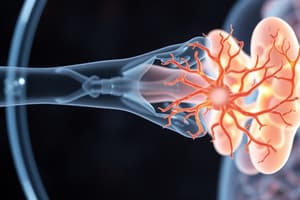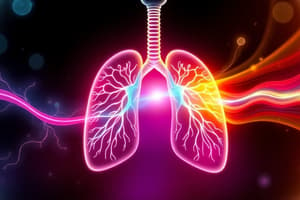Podcast
Questions and Answers
How does exercise influence gas exchange efficiency in the cardiovascular system?
How does exercise influence gas exchange efficiency in the cardiovascular system?
Exercise increases the demand for oxygen consumption and carbon dioxide removal, enhancing gas exchange efficiency.
What role does the ventilatory system play during physical exercise?
What role does the ventilatory system play during physical exercise?
The ventilatory system increases breathing rate and depth to supply oxygen and expel carbon dioxide efficiently.
Explain how lactic acid metabolism is related to exercise-induced changes in gas exchange.
Explain how lactic acid metabolism is related to exercise-induced changes in gas exchange.
Lactic acid accumulation during intense exercise indicates a shift to anaerobic metabolism, which can affect oxygen and carbon dioxide exchange.
How can cardiopulmonary exercise testing (CPET) assist in diagnosing myocardial ischemia?
How can cardiopulmonary exercise testing (CPET) assist in diagnosing myocardial ischemia?
What is the relationship between O2 uptake and CO2 output during exercise?
What is the relationship between O2 uptake and CO2 output during exercise?
Describe how the body compensates for the increased respiratory demands during exercise.
Describe how the body compensates for the increased respiratory demands during exercise.
How does inadequate increase in V̇O2 affect the cardiovascular system during exercise?
How does inadequate increase in V̇O2 affect the cardiovascular system during exercise?
Why is it important to measure gas exchange during exercise testing?
Why is it important to measure gas exchange during exercise testing?
What equation relates V̇CO2, alveolar ventilation (VA), and arterial CO2 tension (PaCO2)?
What equation relates V̇CO2, alveolar ventilation (VA), and arterial CO2 tension (PaCO2)?
Why is rapid elimination of CO2 important during moderate physical activity?
Why is rapid elimination of CO2 important during moderate physical activity?
What factors can impact gas exchange efficiency during exercise?
What factors can impact gas exchange efficiency during exercise?
What role does ventilatory control play in regulating arterial pH?
What role does ventilatory control play in regulating arterial pH?
How does cardiac output change relative to metabolic rate during physical exertion?
How does cardiac output change relative to metabolic rate during physical exertion?
What occurs to the body's total H+ equivalent during moderate exercise?
What occurs to the body's total H+ equivalent during moderate exercise?
What indicates ineffective gas exchange efficiency in a patient with myocardial ischemia?
What indicates ineffective gas exchange efficiency in a patient with myocardial ischemia?
Why must ventilation increase at a rate closely linked to CO2 exchange during physical activity?
Why must ventilation increase at a rate closely linked to CO2 exchange during physical activity?
How do chronic obstructive pulmonary disease (COPD) patients exhibit impaired V̇O2 kinetics?
How do chronic obstructive pulmonary disease (COPD) patients exhibit impaired V̇O2 kinetics?
What physiological mechanism causes dyspnea in patients with left ventricular failure?
What physiological mechanism causes dyspnea in patients with left ventricular failure?
What is the significance of ventilation–perfusion mismatching in lung function?
What is the significance of ventilation–perfusion mismatching in lung function?
How can cardiopulmonary exercise testing (CPET) aid in diagnosing organ efficiency?
How can cardiopulmonary exercise testing (CPET) aid in diagnosing organ efficiency?
What role does lactic acid play in the assessment of exercise capacity in patients?
What role does lactic acid play in the assessment of exercise capacity in patients?
Why might exercise-induced hypoxemia stimulate greater ventilatory drive?
Why might exercise-induced hypoxemia stimulate greater ventilatory drive?
In what way does maximal ventilatory ability relate to exercise performance in diseased states?
In what way does maximal ventilatory ability relate to exercise performance in diseased states?
How does effective change in V̇O2 at the transition from rest to exercise reflect a patient's fitness level?
How does effective change in V̇O2 at the transition from rest to exercise reflect a patient's fitness level?
Flashcards
Gas Exchange
Gas Exchange
The process of taking in oxygen (O2) and releasing carbon dioxide (CO2) during exercise.
V̇O2
V̇O2
Rate of oxygen uptake during exercise.
V̇CO2
V̇CO2
Rate of carbon dioxide output during exercise.
CPET
CPET
Signup and view all the flashcards
O2 deficit
O2 deficit
Signup and view all the flashcards
Ventilation
Ventilation
Signup and view all the flashcards
Tidal Volume
Tidal Volume
Signup and view all the flashcards
Breathing Frequency
Breathing Frequency
Signup and view all the flashcards
Alveolar Ventilation (V̇A)
Alveolar Ventilation (V̇A)
Signup and view all the flashcards
PaCO2
PaCO2
Signup and view all the flashcards
PB
PB
Signup and view all the flashcards
Exercise capacity
Exercise capacity
Signup and view all the flashcards
Ventilation-perfusion Mismatch
Ventilation-perfusion Mismatch
Signup and view all the flashcards
Cardiac output
Cardiac output
Signup and view all the flashcards
Metabolic Demand
Metabolic Demand
Signup and view all the flashcards
Lactic Acidosis
Lactic Acidosis
Signup and view all the flashcards
Arterial pH
Arterial pH
Signup and view all the flashcards
Chronic Obstructive Pulmonary Disease (COPD)
Chronic Obstructive Pulmonary Disease (COPD)
Signup and view all the flashcards
Left Ventricular Failure
Left Ventricular Failure
Signup and view all the flashcards
Study Notes
Gas Exchange During Exercise
- Gas exchange involves O2 uptake (V̇O2) and CO2 output (V̇CO2), both impacted differently by ATP regeneration sources.
- Increasing oxygen demand during exercise leads to elevated O2 consumption (Q̇O2) and CO2 production (Q̇CO2) by contracting muscles.
- Evaluating external respiration responses during exercise can provide insights into the health of organ systems related to cellular respiration.
Cardiopulmonary Exercise Testing (CPET)
- CPET allows simultaneous assessment of cellular, cardiovascular, and ventilatory responses under metabolic stress.
- It highlights the importance of gas exchange measurements for evaluating exercise capacity, especially in patients with chronic conditions.
- Inadequate V̇O2 kinetics during exercise can indicate decreased fitness levels, especially in chronic obstructive pulmonary disease patients.
Factors Influencing Gas Exchange
- The O2 deficit is influenced by the difference between required steady-state V̇O2 and actual V̇O2 during exercise transitions.
- Diseases affecting ventilatory mechanics can lead to increased difficulty in CO2 elimination and gas exchange.
- Conditions like left ventricular failure may result in high lactic acidosis and poor lung gas exchange due to ventilation–perfusion mismatching.
Ventilation and CO2 Regulation
- Ventilation is calculated as tidal volume (VT) multiplied by breathing frequency (f) and correlates with CO2 production.
- An equation represents the relationship for CO2 output: V̇CO2 = V̇A × PaCO2/PB; with V̇A being minute alveolar ventilation, PaCO2 the arterial CO2 pressure, and PB the barometric pressure.
- Maintaining arterial pH requires a quick and precise increase in ventilation to manage increased CO2 levels efficiently.
Summary of Metabolic Demand
- The body produces approximately 40,000 μmol/min of H+ from metabolism, necessitating efficient CO2 elimination to regulate pH.
- As metabolic rates rise, cardiac output increases, but this is less than proportional to the rise in metabolic demand, leading to enhanced O2 extraction by muscles.
- During moderate exercise, minute ventilation increases proportionately to CO2 exchanged at the lungs, underscoring the reliance on respiratory control mechanisms to maintain acid-base balance.
Studying That Suits You
Use AI to generate personalized quizzes and flashcards to suit your learning preferences.
Related Documents
Description
This quiz focuses on the mechanisms of gas exchange during exercise, particularly the uptake of O2 and output of CO2. It explores how different ATP regeneration sources affect respiratory demands in contracting muscles. Test your understanding of the physiological adaptations during physical activity.




